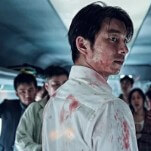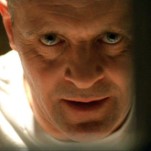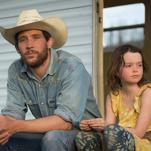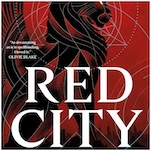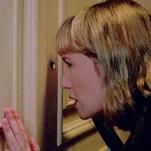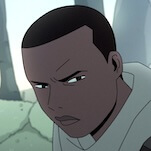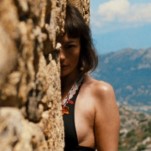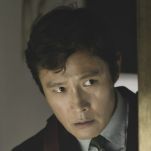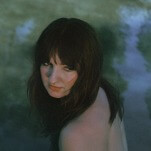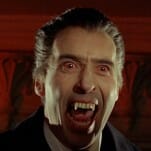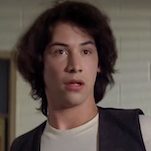How USA’s Dream-Themed Falling Water Gets Inside Its Characters’ Heads
Photo: Ben Mark Holzberg/USA Network
“You get about 3/4 of the way up and then you really question whether you can get back down.”
It’s a brisk fall afternoon somewhere outside downtown Toronto, and Falling Water production designer Andrew Stearn is showing off one of the second season’s most vertiginous practical effects: a curved, vanishing-perspective staircase with a floral runner, each subsequent step 3/8ths of an inch narrower than the previous one. As Stearn and brand-new showrunner Rémi Aubuchon explain on our tour of the USA drama’s soundstages, visual effects will be added in post-production to situate the staircase in a white void—part of the kitchen-sink approach the Season Two team has taken to craft each character’s distinct and compelling dreamscape.
“I think what we decided early on in the production period—and we spent a lot of time going over ideas—was that everybody, we all dream differently, and dreams are different,” Stearn says when I ask about the series’ guiding principles for dream sequences.
“It can’t just be like, somebody says, ‘Oh, I had this fantastic idea for a dream, and it’s going to be that you look up and there’s the sea above you, and the world is reversed,’” Aubuchon adds. “That is a great image, and we may use that at some point, but the dream has to be relevant for that character, and to what that character’s going through. Even though we want it to be fantastical and elaborate and interesting, it’s not just random.”
After a debut season that earned mixed reviews and attracted a small but consistent audience—the Season One finale drew 470,000 viewers—refining the series’ approach to dreams has been one of the main goals for Aubuchon (Powers), who replaces co-creator Blake Masters. Indeed, the premise itself resists being reduced to an elevator pitch: Falling Water follows three disparate protagonists—Burton (David Ajala), security chief at a shadowy operation called The Firm; Tess (Lizzie Brocheré), a trend-spotter in search of her lost son; and Taka (Will Yun Lee), a police officer dealing with his mother’s poor health—who discover that they are dreaming a common dream. Though he uses gentler terms, Aubuchon echoes the critics who called Season One “plodding” and “painfully slow” when he discusses Falling Water’s new tack.
“It was a somewhat intellectualized drama in the first season, and we wanted to take that and push some adrenaline into it,” he says, referring to a procedural element that’s been added this time around: Taka and his partner, Alex Simms (played by Sepideh Moafi) are working a case that the former believes has dream-world connections. “If the first season was all about our characters trying to figure out what they have, who they are, how they fit in, what the big scheme is, our season is about taking those skills that they’ve learned and finding out, ‘What are we supposed to do with them?’’ and put them on a bit of an adventure… We keep calling this ‘an exciting and odd existential drama.’”
Part of that falls to Stearn and other behind-the-scenes talent, what executive producer Tim Andrew describes as a constant collaboration among the writers, the art department, the camera department and others—whether imagining sleek white pods in a subway repair yard (dream-sharing technology, natch) or the dingy, French Connection-inspired 51st Precinct where Taka and Alex are based. (Aubuchon, Andrew, and Stearn each point to one big change for Season Two: Whereas in Season One the series slipped from dream to reality and back without always signaling the viewer, now the distinction will be clear. Based on the two episodes of Season Two provided to critics, they’re right.) Aubuchon describes the creative process as “a jazz ensemble, where we’re all playing the same piece, but we have different things that we’re doing.”
To this end, Aubuchon assigned his writers’ room “as much Jung as possible,” as well as Indian philosophies regarding dreaming and the levels of consciousness—all the better for the writers to tap into their own dreamscapes for inspiration.
-

-

-

-

-

-

-

-

-

-

-

-

-

-

-

-

-

-

-

-

-

-

-

-

-

-

-

-

-

-

-

-

-

-

-

-

-

-

-

-











